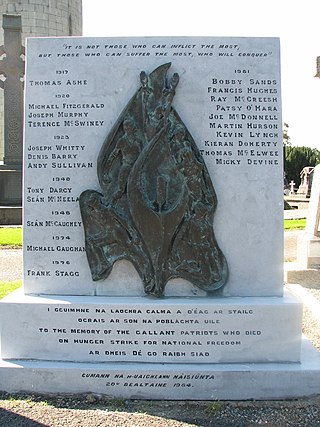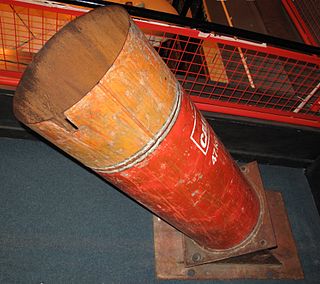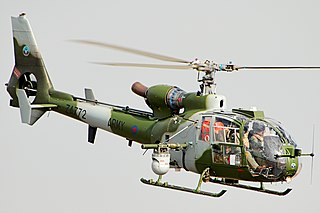
The East Tyrone Brigade of the Provisional Irish Republican Army (IRA), also known as the Tyrone/Monaghan Brigade was one of the most active republican paramilitary groups in Northern Ireland during "the Troubles". It is believed to have drawn its membership from across the eastern side of County Tyrone as well as north County Monaghan and south County Londonderry.
Cullyhanna is a small village and townland close to Keady in County Armagh, Northern Ireland. The village extends further over the townlands of Tullynavall and Freeduff. It had a population of 306 in the 2001 Census. It is within the Newry and Mourne District Council area.

Raymond McCreesh was an Irish volunteer in the South Armagh Brigade of the Provisional Irish Republican Army (IRA). In 1976, he and two other IRA volunteers were captured while attempting to ambush a British Army observation post. McCreesh was one of the ten Irish republicans who died during the 1981 Irish hunger strike in the Maze Prison. McCreesh was one of 22 Irish republicans who died on hunger-strike.

The South Armagh Brigade of the Provisional Irish Republican Army (IRA) operated during the Troubles in south County Armagh. It was organised into two battalions, one around Jonesborough and another around Crossmaglen. By the 1990s, the South Armagh Brigade was thought to consist of about 40 members, roughly half of them living south of the border. It has allegedly been commanded since the 1970s by Thomas 'Slab' Murphy who is also alleged to be a member of the IRA's Army Council. Compared to other brigades, the South Armagh IRA was seen as an 'independent republic' within the republican movement, retaining a battalion organizational structure and not adopting the cell structure the rest of the IRA was forced to adopt after repeated intelligence failures.

Barrack buster is the colloquial name given to several improvised mortars, developed in the 1990s by the engineering unit of the Provisional Irish Republican Army (IRA).

On 13 December 1989 the Provisional Irish Republican Army (IRA) attacked a British Army permanent vehicle checkpoint complex manned by the King's Own Scottish Borderers (KOSB) near the Northern Ireland–Republic of Ireland border at Derryard townland, a few miles north of Rosslea, County Fermanagh. The IRA unit, firing from the back of an armoured dump truck, attacked the small base with heavy machine-guns, grenades, anti-tank rockets and a flamethrower. A nearby Army patrol arrived at the scene and a fierce firefight erupted. The IRA withdrew after leaving a van bomb inside the complex, but the device did not fully detonate. The assault on the outpost left two soldiers dead and two wounded.

Operation Conservation was an attempt by the British Army to ambush a large Provisional Irish Republican Army (IRA) unit along the Dorsey Enclosure, between Cullyhanna and Silverbridge, in south County Armagh. The action took place on 6 May 1990 but was thwarted by the South Armagh Brigade of the IRA.

The Drummuckavall ambush was an attack by the South Armagh Brigade of the Provisional Irish Republican Army (IRA) on a British Army observation post in Drummuckavall, southeast of Crossmaglen, County Armagh, on 22 November 1975. The attack, which occurred along the border with the Republic of Ireland, resulted in the deaths of three British soldiers and underlined the inefficiency of conventional military skills to deal with the situation in South Armagh, prompting the deployment of the Special Air Service (SAS) in this area.

The attack on Cloghoge checkpoint was an unconventional railway bomb attack carried out on 1 May 1992 by the Provisional Irish Republican Army (IRA) against a British Army permanent vehicle checkpoint, manned at the time by members of the Royal Regiment of Fusiliers. The IRA's South Armagh Brigade fitted a van with train wheels that allowed it to move along a railway line. A large bomb was placed inside the van, which was then driven along the railway line to the target. The explosion killed one British soldier and injured 23 others. The complex, just north of the village of Cloghoge in County Armagh, on the southern outskirts of Newry, was utterly destroyed.

The South Armagh Sniper is the generic name given to the members of the Provisional Irish Republican Army's (IRA) South Armagh Brigade who conducted a sniping campaign against the British Army from 1990 to 1997. The campaign is notable for the snipers' use of .50 BMG calibre Barrett M82 and M90 long-range rifles in some of the shootings.
This is a chronology of activities by the Provisional Irish Republican Army (IRA) from 1980 to 1989. For actions before and after this period see Chronology of Provisional Irish Republican Army actions.

On 19 March 1994, a British Army Lynx helicopter was shot down by the Provisional Irish Republican Army (IRA) in Northern Ireland. A unit of the IRA's South Armagh Brigade fired a heavy improvised mortar at the British Army base in Crossmaglen, County Armagh. The mortar round hit and shot down the helicopter, serial number ZD275, while it was hovering over the helipad. Three British soldiers and a Royal Ulster Constabulary (RUC) member were wounded.

On 17 February 1978, a British Army Gazelle helicopter, serial number XX404, went down near Jonesborough, County Armagh, Northern Ireland, after being fired at by a Provisional IRA unit from the South Armagh Brigade. The IRA unit was involved at the time in a gun battle with a Green Jackets observation post deployed in the area, and the helicopter was sent in to support the ground troops. The helicopter crashed after the pilot lost control of the aircraft whilst evading ground fire.

The occupation of Cullaville took place on 22 April 1993, when 12 armed members of the South Armagh Brigade of the Provisional Irish Republican Army (IRA) set up a checkpoint on the main crossroads of Cullaville, County Armagh, Northern Ireland, isolating the small village for a two-hour period, despite the presence of a British Army watchtower some yards away. The IRA men withdrew before the security forces in the area could react.

The Battle of Newry Road was a running gun battle between British Army helicopters and Provisional Irish Republican Army (IRA) armed trucks, fought along the lanes east of Crossmaglen, County Armagh, on 23 September 1993. The engagement began when an IRA motorized team from the South Armagh Brigade attempted to ambush three helicopters lifting off from the British Army base at Crossmaglen, one of them carrying the 3rd Infantry Brigade Commander.
On 11 August 1970, two Royal Ulster Constabulary (RUC) officers were killed by a booby-trap bomb planted under a car by the Provisional Irish Republican Army (IRA) near Crossmaglen, in County Armagh, Northern Ireland. They were the first RUC officers to be killed by republicans during the Troubles and the first security forces to be killed in South Armagh, an IRA stronghold for much of the conflict.
The following is a Timeline of British Army and Royal Ulster Constabulary (RUC) undercover operations during Operation Banner during the 1969 – 1998 Northern Irish conflict in Northern Ireland that resulted in death or injury. Including operations by the SAS, 14 Intelligence Company, the Military Reaction Force (MRF), RUC Special Patrol Group and Special Branch.

On 23 June 1988, an Army Air Corps (AAC) Westland Lynx, serial number XZ664, was shot down by the Provisional Irish Republican Army (IRA) near Aughanduff Mountain, County Armagh, in Northern Ireland. A unit of the IRA's South Armagh Brigade fired at the British Army helicopter using automatic rifles and heavy machine guns. The disabled helicopter was forced to crash-land in an open field; the aircraft and its crew were eventually recovered by British forces.

Throughout the protracted conflict in Northern Ireland (1960s-1998), the Provisional IRA developed a series of improvised mortars to attack British Army and Royal Ulster Constabulary (RUC) security bases. The organisation also purchased both light and heavy machine guns in order to hamper the British Army supply of border bases by helicopter. The IRA fitted vehicles, specially vans and trucks, with both types of weapons. Vans, trucks and tractors were modified to transport concealed improvised mortars to a launch area near the intended target and fire them, while light and heavy trucks were employed as firing platforms mounting machine guns, particularly M60s and DShKs. Improvised armoured vehicles and heavy equipment were also used to penetrate the perimeter of fortified security bases. The IRA vehicles were often disguised as belonging to civilian companies or even government agencies.














